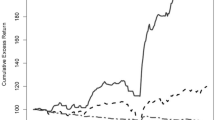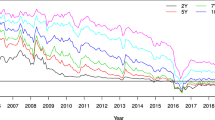Abstract
We study the optimal bond portfolio for an investor with long time horizonusing Japanese interest rate data. A simple one-factor term structure modelis used for our numerical example. The optimal portfolio is computed using thetechnique of stochastic flows and Monte Carlo simulation. The hedgingportfolio is not negligible and the mean variance portfolio is very sensitiveto parameter values. The optimal portfolio is highly leveraged for a typicalparameter value. The investor holds a zero-coupon bond because of the lowerbound restriction on investor's wealth. The lower bound constraint may makethe optimal portfolio more realistic.
Similar content being viewed by others
References
Balduzzi, B. P. and A. Lynch. (1999) Transaction costs and predictability: Some utility cost calculations, J. Financ. Econom. 52, 47-78.
Barberis, N. (2000) Investing for the long run when returns are predictable, J. Finance 55 (1), 225-264.
Brandt, M. W. (1999) Estimating portfolio and consumption choice: A conditional Euler equations approach, J. Finance 54 (5), 1609-1645.
Brennan, M. J. and E. S. Schwartz (1979) A continuous time approach to the pricing of bonds, J. Banking Finance 35, 133-155.
Brennan, M. J., Schwartz, E. S., and Lagnado, R. (1997) Strategic asset allocation, Journal of Economic Dynamics and Control 21 (8-9), 1377-403.
Campbell, J. Y. (1993) Intertemporal asset pricing without consumption data, Amer. Econom. Rev. 83, 487-512.
Campbell, J. Y. and Viceira, L. M. (1999) Consumption and portfolio decisions when expected returns are time varying, Quart. J. Econom. 114 (2), 433-495.
Campbell, J. Y. and Viceira, L. M. (2001) Who should buy long-term bonds? Amer. Econom. Rev. 91 (1), 99-127.
Chan, K. C., Longstaff, F. A., Karolyi, G. A., and Sanders, A. B. (1992) An empirical comparison of alternative models of the short-term interest rate, J. Finance 47 (3), 1209-1227.
Chen, R. R. and Scott, L. (1992) Pricing interest rate options in a two-factor Cox-Ingersoll-Ross model of the term structure, Rev. Financ. Stud. 5 (4), 613-636.
Colwell, D. B., Elliott, R., and Kopp, P. E. (1991) Martingale representation and hedging policies, Stochastic Processes and their Applications 38, 335-345.
Cox, J. C., Ingersoll, J. E., and Ross, S. A. (1980) An analysis of variable rate loan contracts, J. Finance 35, 389-403.
Cox, J. C., Ingersoll, J. E., and Ross. S. A. (1985) A theory of the term structure of interest rates, Econometrica 53 (2), 385-407.
Detemple, J., and Garcia, R., Rindisbacher, M. (1999) A monte-carlo method for optimal portfolios, Boston University. Forthcoming in J. Finance.
Dothan, U. L. (1978) On the term structure of interest rates, J. Financ. Econom. 6, 59-69.
Duan, J.C. and Simonato, J.G. Estimating, exponential-affine term structure models by Kalman filter, Review of Quantitative Finance and Accounting 13 (2), 111-135.
Epstein., L. and Zin, S. (1989) Substitution, risk aversion, and the temporal behavior of consumption and asset returns: A theoretical framework, Econometrica 57, 937-69.
Fournié, E., Lasry, J., Lebuchoux, J., Lions, P., and Touzi, N. (1999) Applications of malliavin calculus to monte carlo methods in finance, Finance and Stochastics 3, 391-412.
Heath, D., Jarrow, J., and Morton, A. (1992) Bond pricing and the term structure of interest rates: A new methodology for contingent claims valuation, Econometrica 60, 77-106.
Hogan, M. (1993) Problems in certain two-factor term structure models, The Annals of Applied Probability 3 (2), 576-581.
Kim, T. and Omberg, E. (1996) Dynamic nonmyopic portfolio behavior, Rev. Financ. Stud. 9 (1), 141-161.
Liu, J. (1998) Portfolio Selection in Stochastic Environments, PhD Thesis, Stanford University.
Lynch, A. (2001) Portfolio choice and equity characteristics: Characterizing the hedging demands induced by return predictability, J. Financ. Econom. 62, 67-130.
Merton, R. C. (1969) Lifetime portfolio selection under uncertainty: The continuous-time case, Rev. Econom. Statist. 51, 247-257.
Merton, R. C. (1971) Optimum consumption and portfolio rules in a continuous-time model, Journal of Economic Theory 3, 373-413.
Nualart, D. (1995) The Malliavin Calculus and Related Topics, Springer-Verlag, New York.
Ocone, D. L. and Karatzas, I. (1991) A generalized clark representation formula, with application to optimal portfolios, Stochastics and Stochastic Reports 34, 187-220.
Protter, P. (1990) Stochastic Integration and Differential Equations, Springer-Verlag, New York.
Samuelson, P. A. (1969) Lifetime portfolio selection by dynamic stochastic programming, Rev. Econom. Statist. 51 (3), 239-246.
Vasicek, O. (1977) An equilibrium characterization of the term structure, J. Financ. Econom. 5, 177-188.
Xia, Y. (2001) Learning about predictability: The effect of parameter uncertainty on optimal dynamic asset allocation, J. Finance 56 (1), 205-246.
Author information
Authors and Affiliations
Rights and permissions
About this article
Cite this article
Fukaya, R., Honda, T. Optimal Bond Portfolio for Investors with Long Time Horizons. Asia-Pacific Financial Markets 8, 291–320 (2001). https://doi.org/10.1023/A:1020639511843
Issue Date:
DOI: https://doi.org/10.1023/A:1020639511843




